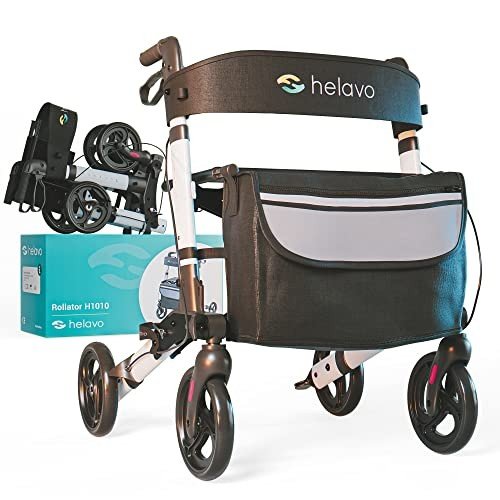Wpis na blogu utworzony przez Mauricio Sherman
The Seat Walker: A Comprehensive Guide to Mobility Aids
When it comes to maintaining independence and mobility, people with limited mobility or specials needs often rely on numerous assistive devices. One such gadget that increasingly pertains to the leading edge of mobility aids is the seat walker. This post provides a thorough look at seat walkers-- their functions, Benefits Of Rollator Walker, types, and the elements to consider when selecting one.
What is a Seat Walker?
A seat walker is a versatile mobility aid designed mostly for people who might have problem walking unaided. It usually features a frame with wheels, deals with for support, and a built-in bench or seat, enabling users to take breaks when needed. Unlike basic walkers or rollators, which just offer support for walking, the addition of a seat makes the seat walker significantly more practical for many users.
Key Features of Seat Walkers
- Wheels: Most seat walkers are geared up with front wheels that enhance mobility and ease of use, allowing users to glide smoothly over numerous surfaces.
- Seat or Bench: The most distinguishing feature is the integrated seat, which provides a resting location for users when fatigue sets in.
- Deals with: Adjustable handles deal with different user heights, supplying appropriate support and ensuring a comfy grip.
- Brakes: Safety brakes avoid the walker from rolling away when someone is seated, enhancing user security.
- Lightweight Frame: Many models are developed to be lightweight, making them much easier to transfer and maneuver.
Benefits of Using a Seat Walker
Seat walkers have various benefits that make them a perfect option for many users.
- Improved Mobility: They provide higher stability and assistance than conventional walkers, lowering the threat of falls.
- Convenience: The capability to rest at any point makes them suitable for those who tire easily or have restricted endurance.
- Self-reliance: Seat walkers enable users to keep a degree of self-reliance by allowing them to stroll and rest without help.
- Flexibility: Suitable for both indoor and outdoor use, these walkers can adapt to various environments.
- Physical Activity: Regular use motivates physical activity and social interaction, which can improve overall wellness.
Types of Seat Walkers
Different types of seat walkers deal with the differing needs of users. Here is a breakdown of the most typical types:
| Type | Functions | Best For |
|---|---|---|
| Fundamental Seat Walker | Basic style, typically with a lightweight frame and very little functions. | Users requiring fundamental mobility assistance. |
| Heavy-Duty Seat Walker | Strengthened frame, higher weight capacity, typically with larger seats. | Individuals requiring more robust support. |
| Rollator For Disabled with Seat | Combines seats with multi-height adjustable deals with and much better maneuverability. | Users requiring frequent resting alternatives. |
| Carry Seat Walker | Created for simple transportation; frequently folds and has a little footprint. | Active users who travel regularly. |
Choosing the Right Seat Walker
Picking a seat walker includes numerous factors to consider to guarantee it meets the user's specific needs. Here are necessary aspects to remember:
- Weight Capacity: Ensure that the seat walker can support the user's weight conveniently.
- Seat Height: Check the height of the seat to guarantee it is suitable and comfy for the user.
- Width: Consider your living space and guarantee the walker can fit through doors and narrow passages.
- Wheel Size: Larger wheels can manage rougher terrain, while smaller sized wheels are much better suited for indoor use.
- Weight of the Walker: A lightweight walker is useful for simple maneuverability and transport.
- Brakes and Safety Features: Look for reliable brakes and safety guarantees, such as stability and anti-tip functions.
Setting a Budget
Seat walkers differ significantly in rate depending on their functions and build quality. While it's important to find a design that satisfies the user's requirements, it's equally essential to set a sensible budget plan.

Average Price Ranges:
- Basic Models: ₤ 50 to ₤ 150
- Rollators with Added Features: ₤ 150 to ₤ 300
- Sturdy Models: ₤ 300 and up
FAQs About Seat Walkers
Q1: Who ought to use a seat walker?A1: Seat walkers are ideal for people with limited mobility due to age, injury, or chronic conditions who need extra assistance while walking. Q2: Are seat walkers safe?A2: Outdoor walker (www.mymobilityscooters.uk) Yes, seat walkers are developed with safety in mind. They usually feature brakes, sturdy frames, and slip-resistant grips. Q3: How do I keep my seat walker?A3: Regularly examine the brakes and wheels for wear and tear.
Clean the frame with a moist cloth and ensure
screws and components are tight. Q4: Can seat walkers be used outdoors?A4: Yes, lots of seat walkers are created for both indoor and outdoor use, though models with larger wheels carry out better on unequal surfaces. Q5: How do I understand
which seat walker is Best Folding Three-Wheel Rollator Walker with Accessories for me?A5: Consult with a health care supplier or occupational therapist who can evaluate your mobility requirements and advise appropriate alternatives based upon your distinct situation. The benefit and adaptability of seat walkers make them an invaluable tool for those with mobility obstacles. By providing support, stability, and an opportunity for rest, they empower users to remain active and independent. When picking a seat walker, individuals need to consider their personal requirements, lifestyle, and safety to find the very best match for them. With the ideal seat walker, lots of users can take pleasure in a renewed sense of freedom, enhancing their lifestyle and preserving their independence. In summary, whether one is navigating through the home, running errands, or enjoying fresh air in a park, a seat walker can show to be an important companion, changing everyday activities into workable tasks.
